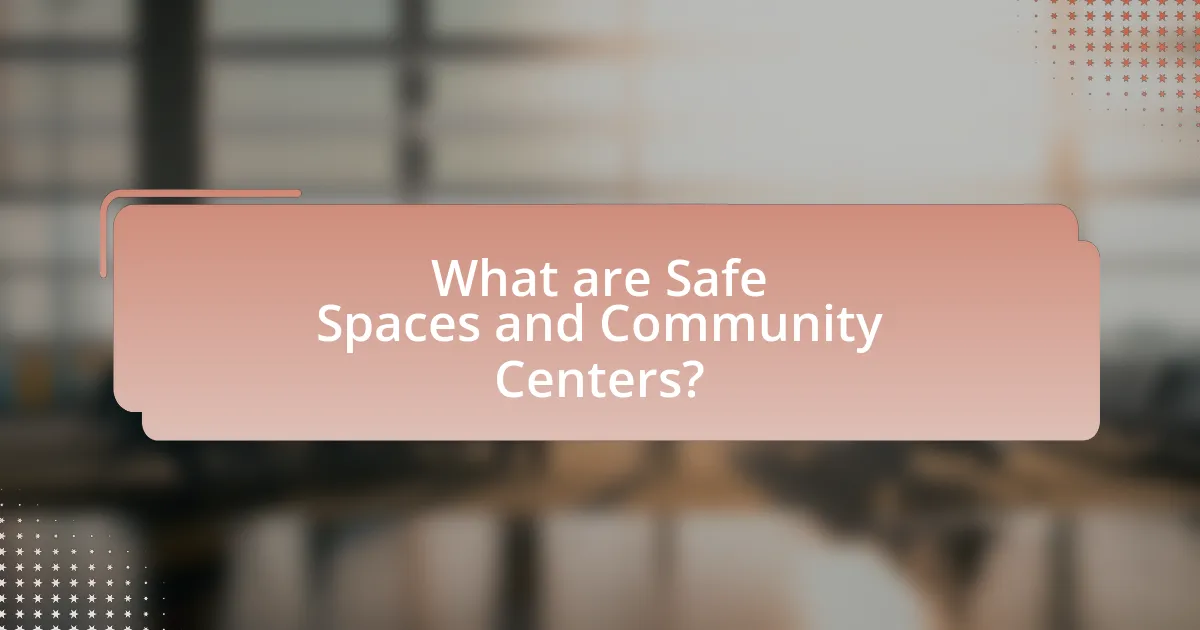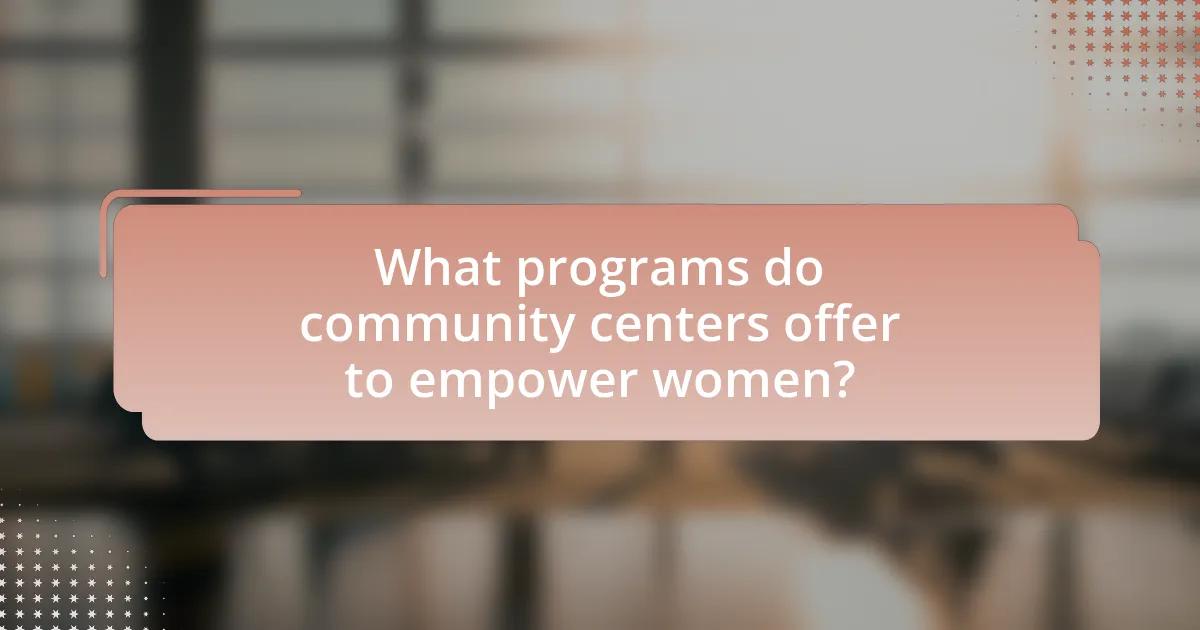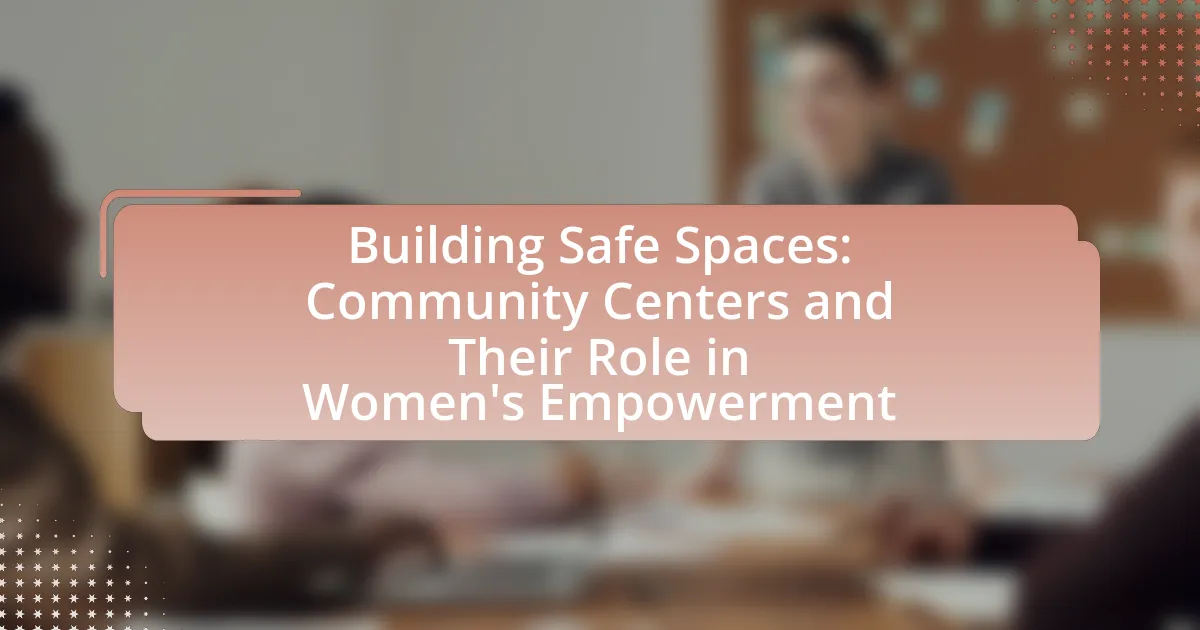The article focuses on the concept of safe spaces and community centers, emphasizing their critical role in promoting women’s empowerment. It outlines how community centers serve as supportive environments that provide resources, programs, and services tailored to the needs of women, including educational workshops, vocational training, and support groups. The article discusses the importance of these centers in fostering safety, confidence, and mental well-being among women, while also addressing the challenges they face, such as funding limitations and cultural barriers. Additionally, it highlights best practices for community centers to enhance their effectiveness in empowering women and the significance of community feedback in program development.

What are Safe Spaces and Community Centers?
Safe spaces are designated environments that promote safety, acceptance, and support for individuals, particularly marginalized groups, allowing them to express themselves without fear of discrimination or harm. Community centers serve as physical locations that provide resources, programs, and services aimed at fostering community engagement, social interaction, and empowerment, often focusing on the needs of specific populations, including women. Research indicates that community centers play a crucial role in women’s empowerment by offering educational programs, support networks, and resources that enhance women’s skills and confidence, thereby contributing to their overall well-being and social inclusion.
How do community centers function as safe spaces for women?
Community centers function as safe spaces for women by providing a supportive environment that fosters empowerment, connection, and resources. These centers often offer programs specifically designed for women, such as workshops on self-defense, mental health support, and career development, which help to build confidence and skills. Additionally, community centers serve as venues for social gatherings, allowing women to form networks and friendships that enhance their sense of belonging and security. Research indicates that women who participate in community center activities report increased feelings of safety and support, highlighting the centers’ role in combating isolation and promoting well-being.
What features make a community center a safe space?
A community center becomes a safe space through features such as inclusive programming, trained staff, and secure facilities. Inclusive programming ensures that diverse groups feel welcome and represented, fostering a sense of belonging. Trained staff are essential for addressing conflicts, providing support, and ensuring that all individuals feel respected and safe. Secure facilities, including well-lit areas, accessible entrances, and surveillance systems, contribute to physical safety, which is crucial for creating an environment where individuals can engage freely. These features collectively enhance the community center’s role as a supportive environment, particularly for marginalized groups, including women.
How do community centers ensure safety for women?
Community centers ensure safety for women by implementing various security measures and creating supportive environments. These centers often employ trained staff and security personnel to monitor activities and provide assistance when needed. Additionally, many community centers establish protocols for reporting harassment or violence, ensuring that women feel safe to voice their concerns.
Furthermore, community centers frequently offer self-defense classes and workshops focused on personal safety, empowering women with skills and knowledge to protect themselves. Research indicates that environments designed with safety in mind, such as well-lit areas and accessible emergency contacts, significantly reduce the risk of violence against women. By fostering a culture of respect and support, community centers play a crucial role in enhancing women’s safety and well-being.
Why are safe spaces important for women’s empowerment?
Safe spaces are crucial for women’s empowerment because they provide environments where women can express themselves freely, share experiences, and build supportive networks. These spaces foster a sense of belonging and safety, enabling women to engage in discussions about their rights, challenges, and aspirations without fear of judgment or harassment. Research indicates that women who participate in safe spaces report increased confidence and a greater sense of agency, which are essential components of empowerment. For instance, a study by the World Bank found that women in supportive community environments are more likely to pursue education and leadership roles, demonstrating the tangible benefits of safe spaces in promoting women’s empowerment.
What role do safe spaces play in fostering confidence among women?
Safe spaces play a crucial role in fostering confidence among women by providing environments where they can express themselves freely without fear of judgment or discrimination. These spaces encourage open dialogue, allowing women to share experiences, build relationships, and develop a sense of belonging. Research indicates that participation in supportive communities enhances self-esteem and personal growth; for instance, a study published in the Journal of Community Psychology found that women who engaged in community support groups reported increased confidence and empowerment. By facilitating connections and offering resources, safe spaces empower women to assert themselves and pursue their goals.
How do safe spaces contribute to women’s mental health and well-being?
Safe spaces significantly enhance women’s mental health and well-being by providing environments where they can express themselves without fear of judgment or discrimination. These spaces foster a sense of belonging and community, which is crucial for emotional support and resilience. Research indicates that women who participate in supportive community settings report lower levels of anxiety and depression, as they feel validated and empowered through shared experiences. For instance, a study published in the Journal of Community Psychology found that women in safe spaces experienced increased self-esteem and improved coping strategies, demonstrating the direct correlation between such environments and positive mental health outcomes.

What programs do community centers offer to empower women?
Community centers offer various programs to empower women, including vocational training, health and wellness workshops, support groups, and educational seminars. Vocational training programs equip women with skills for employment, while health and wellness workshops focus on physical and mental well-being. Support groups provide a safe space for women to share experiences and challenges, fostering community and resilience. Educational seminars cover topics such as financial literacy, legal rights, and personal development, enhancing women’s knowledge and confidence. These programs collectively contribute to women’s empowerment by promoting independence and community engagement.
How do educational programs in community centers support women’s empowerment?
Educational programs in community centers support women’s empowerment by providing essential skills, knowledge, and resources that enhance women’s social and economic status. These programs often include vocational training, financial literacy workshops, and leadership development, which equip women with the tools necessary to achieve independence and make informed decisions. For instance, a study by the World Bank found that women who participated in community-based educational programs experienced a 30% increase in employment opportunities compared to those who did not engage in such initiatives. This evidence demonstrates that educational programs are crucial in fostering an environment where women can thrive and assert their rights, ultimately contributing to broader societal change.
What types of skills training are commonly offered?
Community centers commonly offer skills training in areas such as vocational skills, financial literacy, digital literacy, and personal development. Vocational skills training includes programs in trades like carpentry, plumbing, and culinary arts, which equip participants with practical job skills. Financial literacy training focuses on budgeting, saving, and managing credit, helping individuals make informed financial decisions. Digital literacy training teaches essential computer skills, internet navigation, and software use, which are increasingly important in the job market. Personal development training often covers communication skills, leadership, and self-esteem building, fostering personal growth and empowerment. These training programs are designed to enhance employability and promote self-sufficiency among participants, particularly women in underserved communities.
How do mentorship programs function within community centers?
Mentorship programs within community centers function by pairing experienced individuals with mentees to provide guidance, support, and skill development. These programs typically focus on fostering personal and professional growth, particularly for marginalized groups, including women. For instance, community centers often implement structured mentorship initiatives that include workshops, one-on-one sessions, and networking opportunities, which are designed to enhance participants’ confidence and capabilities. Research indicates that mentorship can significantly improve career outcomes and personal development, as evidenced by a study published in the Journal of Vocational Behavior, which found that mentees reported higher job satisfaction and career advancement.
What role do support groups play in community centers?
Support groups in community centers provide essential emotional and social support, fostering a sense of belonging among participants. These groups facilitate open discussions, allowing individuals to share experiences and challenges, which can lead to improved mental health and resilience. Research indicates that participation in support groups can significantly reduce feelings of isolation and anxiety, enhancing overall well-being. For instance, a study published in the Journal of Community Psychology found that individuals engaged in support groups reported a 30% increase in perceived social support and a 25% decrease in depressive symptoms. Thus, support groups play a crucial role in empowering individuals, particularly women, by creating safe spaces for connection and personal growth within community centers.
How do support groups help women share their experiences?
Support groups help women share their experiences by providing a safe and supportive environment where they can openly discuss personal challenges and feelings. This setting fosters trust and encourages vulnerability, allowing women to connect with others who have similar experiences. Research indicates that sharing experiences in support groups can lead to improved emotional well-being, as participants often report feeling less isolated and more understood. A study published in the Journal of Community Psychology found that women in support groups experienced significant reductions in anxiety and depression, highlighting the therapeutic benefits of shared experiences.
What resources are available through these support groups?
Support groups provide various resources, including emotional support, educational workshops, and access to mental health services. These resources are designed to empower individuals by fostering a sense of community and belonging. For instance, many support groups offer workshops on topics such as self-esteem, financial literacy, and coping strategies, which are essential for personal development. Additionally, support groups often connect members with local mental health professionals, providing access to counseling and therapy services. This multifaceted approach not only addresses immediate emotional needs but also equips individuals with skills and knowledge for long-term empowerment.
How can community centers effectively promote women’s empowerment?
Community centers can effectively promote women’s empowerment by providing targeted programs that enhance skills, foster leadership, and create supportive networks. These centers can offer workshops on financial literacy, self-defense, and career development, which are essential for building confidence and independence among women. Research indicates that women who participate in community programs report increased self-efficacy and improved social connections, which are critical for empowerment. For instance, a study by the Women’s Foundation of California found that women involved in community-based initiatives experienced a 30% increase in leadership roles within their communities. By creating safe spaces for dialogue and collaboration, community centers can facilitate the sharing of experiences and resources, further strengthening women’s empowerment.
What strategies can community centers implement to engage women?
Community centers can implement targeted outreach programs, skill-building workshops, and support groups to engage women effectively. These strategies create inclusive environments where women feel valued and empowered. For instance, offering workshops on financial literacy or health education can attract women seeking personal development. Additionally, establishing support groups for various interests, such as parenting or career advancement, fosters community and connection among women. Research indicates that women are more likely to participate in programs that address their specific needs and interests, enhancing their engagement and sense of belonging within the community.
How can outreach programs increase participation among women?
Outreach programs can increase participation among women by creating inclusive environments that address their specific needs and barriers. These programs often provide tailored resources, such as childcare services, flexible scheduling, and targeted communication strategies that resonate with women. For instance, a study by the Women’s Foundation of California found that programs offering childcare increased attendance by 40% among women with children, demonstrating the effectiveness of addressing logistical barriers. Additionally, outreach initiatives that foster community engagement and peer support can enhance women’s confidence and motivation to participate, as evidenced by the success of community centers that host women-focused events and workshops.
What partnerships can enhance the effectiveness of community centers?
Partnerships with local government agencies, non-profit organizations, educational institutions, and healthcare providers can enhance the effectiveness of community centers. Local government agencies can provide funding and resources, while non-profit organizations can offer specialized programs and services that address community needs. Educational institutions can facilitate workshops and training sessions, promoting skill development and empowerment. Healthcare providers can deliver essential health services and information, contributing to the overall well-being of community members. These collaborations create a comprehensive support network that strengthens the community center’s role in women’s empowerment and fosters a safe environment for all.
What challenges do community centers face in empowering women?
Community centers face several challenges in empowering women, including limited funding, cultural barriers, and inadequate outreach. Limited funding restricts the resources available for programs aimed at women’s empowerment, resulting in fewer opportunities for skill development and support services. Cultural barriers often hinder women’s participation, as societal norms may discourage them from engaging in community activities. Additionally, inadequate outreach efforts can lead to a lack of awareness about available programs, preventing women from accessing the support they need. These challenges collectively impede the effectiveness of community centers in fostering an environment conducive to women’s empowerment.
How can funding limitations impact community center programs?
Funding limitations can severely restrict community center programs by reducing the availability of resources necessary for effective operation. When funding is inadequate, community centers may struggle to offer essential services such as educational workshops, health programs, and recreational activities, which are vital for community engagement and empowerment. For instance, a study by the National Council of Nonprofits indicates that 70% of nonprofits reported cuts in funding, leading to program reductions or closures. This directly affects the ability of community centers to support women’s empowerment initiatives, as fewer programs mean less access to resources that foster personal and professional development.
What barriers do women face in accessing community center resources?
Women face several barriers in accessing community center resources, including lack of transportation, limited awareness of available services, and cultural stigmas. Transportation issues often prevent women from reaching community centers, particularly in rural areas where public transit is scarce. Additionally, many women may not be informed about the resources offered, as outreach efforts may not effectively target them. Cultural stigmas can also discourage women from seeking help or participating in programs, particularly in communities where traditional gender roles are prevalent. These barriers collectively hinder women’s ability to fully utilize community center resources, impacting their empowerment and access to support.
What best practices can community centers adopt for success?
Community centers can adopt best practices such as fostering inclusive programming, engaging with local stakeholders, and ensuring sustainable funding to achieve success. Inclusive programming addresses the diverse needs of the community, which can be evidenced by studies showing that centers with varied activities attract a broader audience and enhance participation rates. Engaging with local stakeholders, including residents and organizations, builds trust and ensures that the services provided are relevant and effective, as demonstrated by community engagement models that highlight increased satisfaction and utilization of services. Sustainable funding strategies, such as diversifying revenue sources through grants, partnerships, and fundraising events, are crucial; research indicates that centers with multiple funding streams are more resilient and capable of maintaining operations during economic downturns.
How can community centers measure the impact of their programs on women’s empowerment?
Community centers can measure the impact of their programs on women’s empowerment through quantitative and qualitative assessments, including surveys, interviews, and program participation metrics. For instance, pre- and post-program surveys can evaluate changes in participants’ self-esteem, decision-making abilities, and economic independence, providing measurable data on empowerment outcomes. Additionally, tracking attendance and engagement levels can indicate the effectiveness of programs in fostering a supportive environment. Research shows that programs focused on skill development and community engagement lead to increased confidence and leadership among women, as evidenced by studies conducted by the World Bank, which highlight the correlation between participation in community programs and improved socio-economic status for women.
What role does community feedback play in program development?
Community feedback is essential in program development as it ensures that the programs meet the actual needs and preferences of the target population. By actively soliciting and incorporating feedback from community members, program developers can identify gaps, improve services, and enhance overall effectiveness. For instance, a study by the National Community Development Association found that programs designed with community input are 30% more likely to achieve their intended outcomes, demonstrating the significant impact of community engagement on program success.


